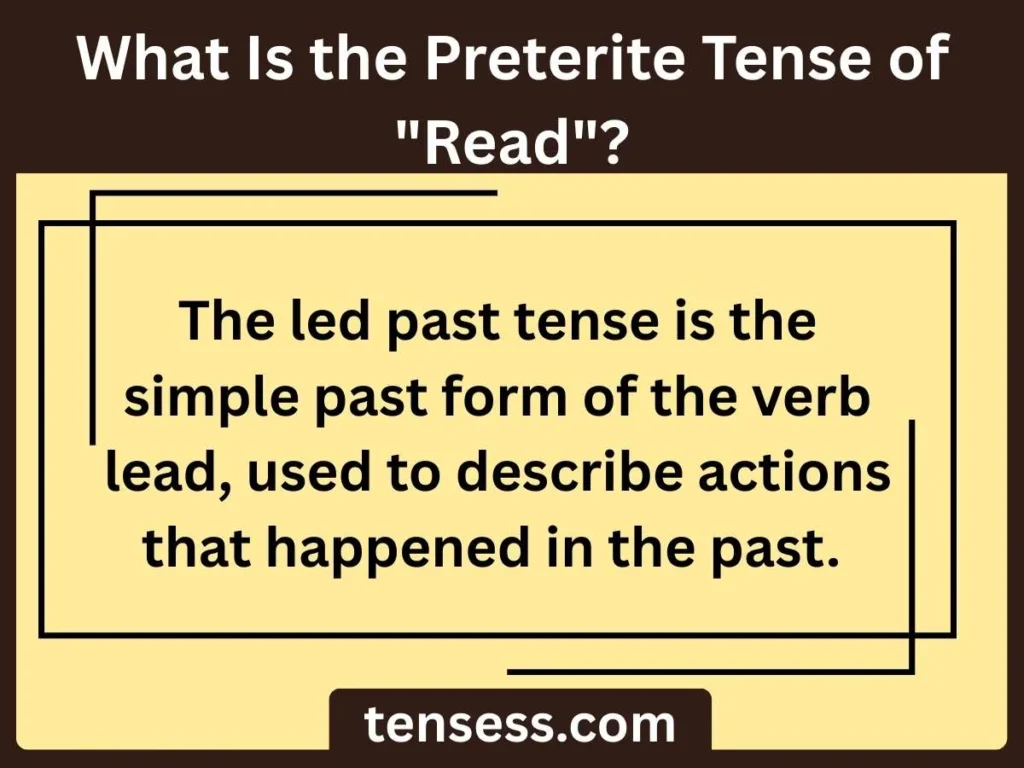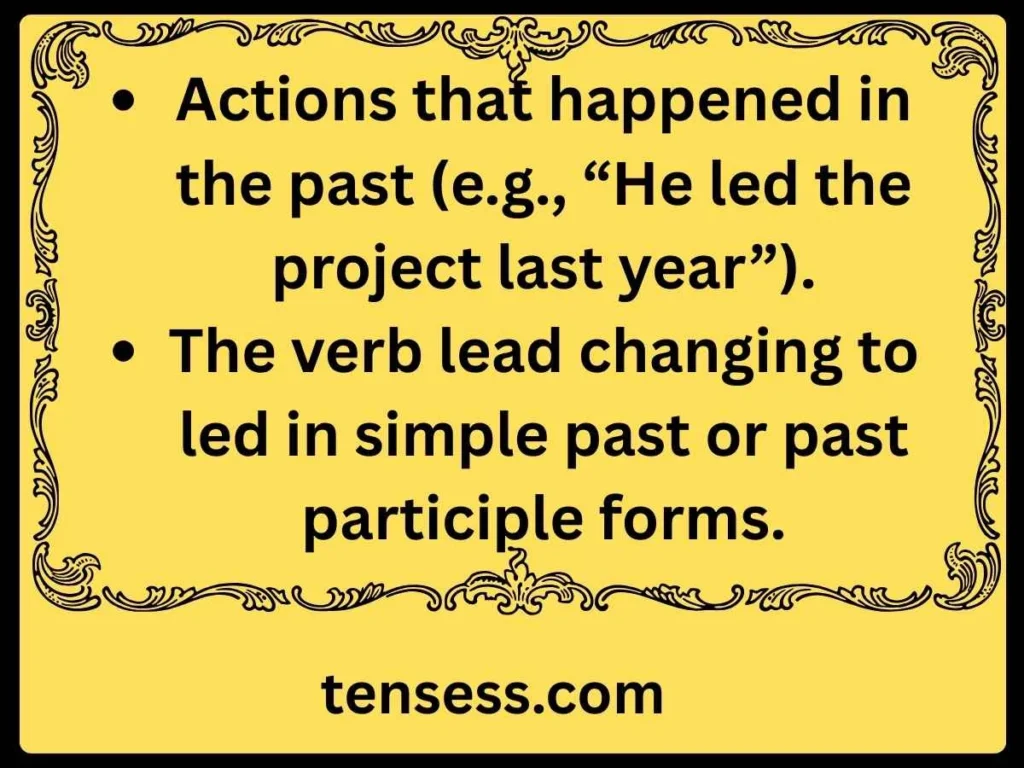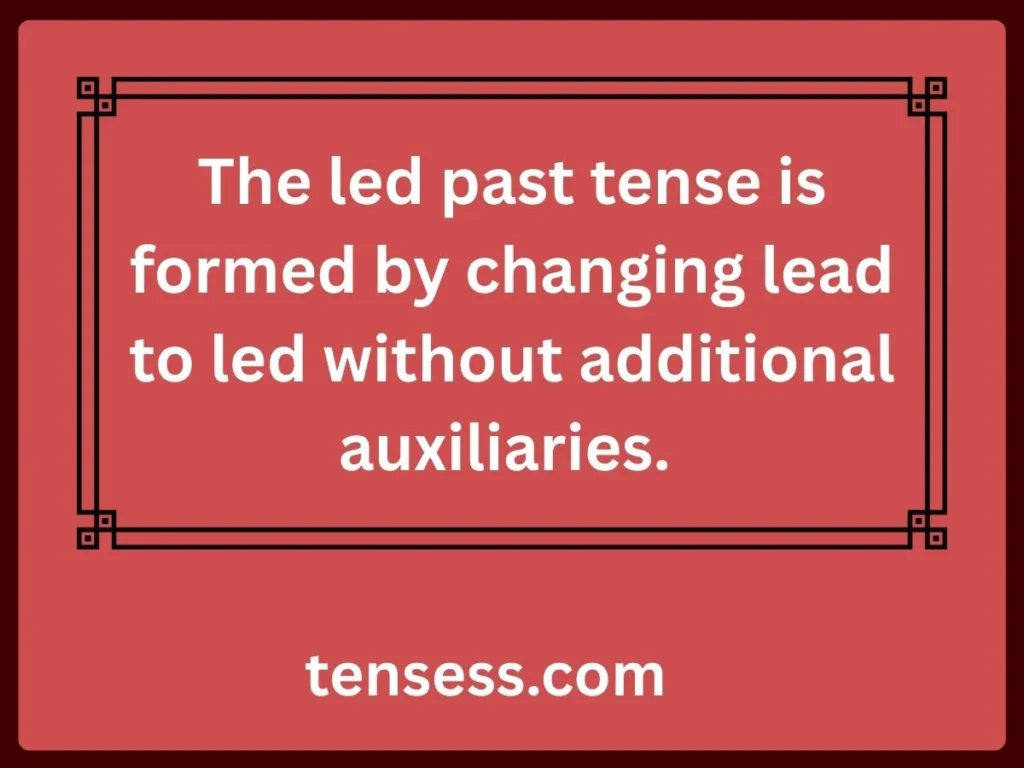Introduction
The past tense of lead, which is led, is a key concept for students, language learners, writers, and grammar enthusiasts.
Understanding how to use led correctly can enhance your writing and communication skills.
The verb lead (pronounced /li:d/) means to guide or direct, but its past tense, led (pronounced /led/), often confuses learners due to its irregular form and similar-sounding words like lead (the metal, pronounced /led/).
This SEO-optimized blog article will break down the definition, formation, and usage of led in a beginner-friendly way.
With clear explanations, real-life verb tense examples, and practical tips, you’ll master led in no time.
If you’re crafting essays or polishing your English, this guide will help you use the led past tense confidently.
Let’s dive into the structure, conjugation, and common pitfalls to ensure you use led correctly in every sentence.
What Is the Past Tense of Lead?

For example, “She led the team to victory yesterday.” It indicates a completed action where someone guided, directed, or influenced others. Unlike the present tense lead, which is pronounced /li:d/, the past tense led is pronounced /led/, making it distinct in both spelling and sound. Recognizing led as the correct past tense of lead is crucial for clear communication, especially since it’s often confused with lead (the metal) or the present tense.
Recognition of Past Tense of Lead
To identify the led past tense, look for:

- Contexts involving guidance, direction, or leadership (e.g., “They led the parade”).
Structure of Sentence of Past Tense of Lead
Sentences using led typically follow this structure:

- No auxiliary verbs are needed in the simple past tense.
- Can be paired with adverbs or prepositional phrases (e.g., “She led confidently”).
Formation of Past Tense of Lead

For example:
- Present: “I lead the group.”
- Past: “I led the group.”
Verbs
The verb lead is an irregular verb, meaning it doesn’t follow the standard “-ed” ending for past tense (e.g., walk → walked). Instead, lead becomes led in both simple past and past participle forms.
Helping Verbs
In the simple past, led doesn’t require helping verbs. However, in perfect tenses (e.g., past perfect), led pairs with have, has, or had (e.g., “She had led the team”).
Define the Verb in That Specific Tense
Led is the simple past and past participle of lead, indicating a completed action of guiding or directing in the past.
Regular or Irregular?
Lead is an irregular verb. Its past tense (led) doesn’t follow the regular “-ed” pattern, which often trips up learners.
10 Simple Sentence Examples
- She led the choir during the performance.
- He led the hikers through the forest.
- They led the campaign successfully.
- I led the meeting last week.
- We led the group to safety.
- The coach led the team to the finals.
- You led the discussion brilliantly.
- The guide led us to the summit.
- The teacher led the class in a debate.
- John led the project to completion.
How to Conjugate Led Tense
Conjugating led is straightforward since it’s the same for all subjects in the simple past tense. Here’s how to use it:
- Use led for all subjects (I, you, he, she, it, we, they).
- No auxiliary verbs are needed in simple past.
- For past perfect, use had led (e.g., “I had led”).
- Ensure correct pronunciation (/led/, not /li:d/).
- Avoid confusing led with lead (the metal).
- Use led in active voice sentences (e.g., “She led the team”).
- Pair with time expressions like “yesterday” or “last year.”
- Check spelling to avoid “lead” in past tense contexts.
- Use led in both simple past and past participle forms.
- Practice with varied subjects to master usage.
Conjugation Table
| Subject | Simple Past | Past Participle |
| I | led | led |
| You | led | led |
| He/She/It | led | led |
| We | led | led |
| They | led | led |
Spelling Changes or Irregularities
- Lead changes to led in past tense, dropping the “a” and adding “-ed.”
- No other spelling changes occur.
- Irregularity: Doesn’t follow the regular “-ed” ending pattern (e.g., talk → talked).
Examples of Led Tense Sentences
Here are 10–15 verb tense examples with different subjects:
- I led the book club discussion last night.
- You led the team to a major breakthrough.
- She led the protest with confidence.
- He led the expedition across the desert.
- It (the dog) led us to the hidden treasure.
- We led the fundraiser for the school.
- They led the parade through the city.
- The manager led the staff meeting efficiently.
- John and Sarah led the charity event.
- The captain led the ship to shore.
- My friend led the tour group in Paris.
- The kids led the cleanup effort.
- Our team led the competition in sales.
- The professor led a fascinating lecture.
- I had led the group before she took over.
Common Mistakes with Led Tense
Here are common errors and how to avoid them:
- Confusing “led” with “lead” (metal): Use led for past tense, not lead (e.g., Wrong: “He lead the team.” Right: “He led the team.”).
- Mispronouncing “led”: It’s /led/, not /li:d/.
- Using “lead” in past tense: Always use led for past actions.
- Forgetting irregularity: Lead doesn’t take “-ed” like regular verbs.
- Mixing tenses: Avoid “She has lead” (use “She has led”).
- Spelling errors: Double-check led vs. lead.
- Incorrect past perfect: Use “had led,” not “had lead.”
- Overusing helping verbs: Simple past led doesn’t need auxiliaries.
- Confusing with synonyms: Led (guided) isn’t the same as “directed” or “managed” in all contexts.
- Ignoring context: Ensure led fits the meaning of guiding or directing.
Related Verbs and Synonyms for Led
Synonyms for lead (and led) include guide, direct, steer, conduct, and manage. These verbs may overlap but differ in nuance:
- Guide: Suggests gentle direction (e.g., “She guided the tourists” vs. “She led the tourists”).
- Direct: Implies authority (e.g., “He directed the play” vs. “He led the play”).
- Steer: Indicates subtle guidance (e.g., “They steered the conversation” vs. “They led the conversation”).
- Conduct: Often used formally (e.g., “She conducted the orchestra” vs. “She led the orchestra”).
- Manage: Focuses on control (e.g., “He managed the team” vs. “He led the team”).
Sentence Comparisons
- Led vs. Guided: “She led the group to the museum” (direct leadership) vs. “She guided the group through the museum” (assisted navigation).
- Led vs. Directed: “He led the meeting” (general oversight) vs. “He directed the meeting” (specific instructions).
Tips to Practice Using Led Tense
- Write 5 sentences daily using led with different subjects.
- Read articles and highlight instances of led.
- Practice speaking sentences with led to master pronunciation.
- Use flashcards to differentiate lead and led.
- Create a story where a character led a group.
- Pair led with time expressions (e.g., “last week”).
- Check your writing with a grammar tool to catch errors.
- Practice past perfect (e.g., “had led”) in complex sentences.
- Compare led with synonyms in practice sentences.
- Join a writing group to get feedback on led usage.
Frequently Asked Questions
- What is the past tense of lead?
The past tense of lead (/li:d/) is led (/led/). - Is “lead” ever used in the past tense?
No, lead (pronounced /led/) refers to the metal or present tense. Use led for past tense. - Is “led” a regular or irregular verb?
Led is the past tense of the irregular verb lead. - How do you pronounce “led”?
It’s pronounced /led/, not /li:d/. - What’s the past participle of lead?
The past participle is also led (e.g., “She has led”). - Can “led” be used with all subjects?
Yes, led is the same for all subjects (I, you, he, etc.). - What’s the difference between “led” and “guided”?
Led implies leadership, while guided suggests gentle direction. - How do I avoid confusing “lead” and “led”?
Remember: lead (/li:d/) is present; led (/led/) is past. - Is “had lead” correct?
No, use “had led” for past perfect tense. - Where can I practice “led”?
Try writing exercises, quizzes, or grammar apps.
Exercises
- Write 5 sentences using led with different subjects.
- Correct this sentence: “She lead the team yesterday.”
- Create a dialogue where one character led an event.
- Fill in the blank: “He ___ the group to safety.”
- Rewrite “They guided the tourists” using led.
- Identify the error: “I have lead the project.”
- Use led in a past perfect sentence.
- Combine led with “last month” in a sentence.
- Write a sentence with led and an adverb (e.g., confidently).
- Create a short paragraph about a leader who led a team.
Quizzes
- What is the past tense of lead? (A) Lead (B) Led (C) Leaded
Answer: (B) Led - Which is correct? (A) She lead the choir (B) She led the choir
Answer: (B) She led the choir - How do you say led? (A) /li:d/ (B) /led/
Answer: (B) /led/ - Is lead a regular verb? (A) Yes (B) No
Answer: (B) No - What’s the past participle of lead? (A) Led (B) Lead
Answer: (A) Led - Correct this: “They had lead the group.”
Answer: They had led the group. - Which synonym fits? “She led the team.” (A) Guided (B) Watched
Answer: (A) Guided - Fill in: “I ___ the meeting yesterday.”
Answer: I led the meeting yesterday. - Which is wrong? (A) He led the project (B) He lead the project
Answer: (B) He lead the project - Use led in a sentence with “we.”
Answer: We led the campaign successfully.
Conclusion
Mastering the led past tense of lead is essential for clear and confident communication.
By understanding its formation, recognizing its irregular nature, and practicing with real-life verb tense examples, you can avoid common mistakes like confusing led with lead.
This guide has provided a clear path to using led correctly, from conjugation tables to practical exercises.
Whether you’re a student, writer, or language learner, applying these tips will strengthen your grammar skills.
Try writing sentences with led, use a grammar checker to refine your work, or join a writing group to practice further.
With consistent practice, you’ll use the led past tense effortlessly in any context.
Share your own led sentences in the comments or test your skills with our quizzes to keep improving!



